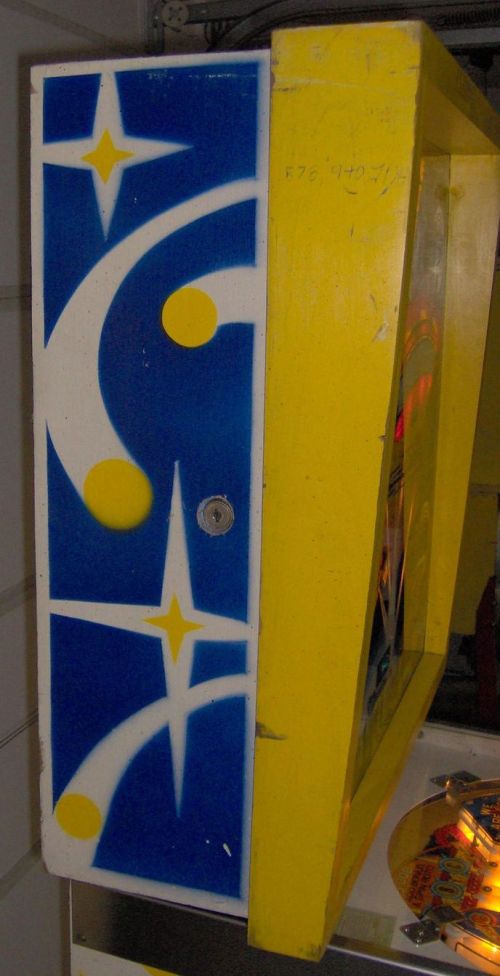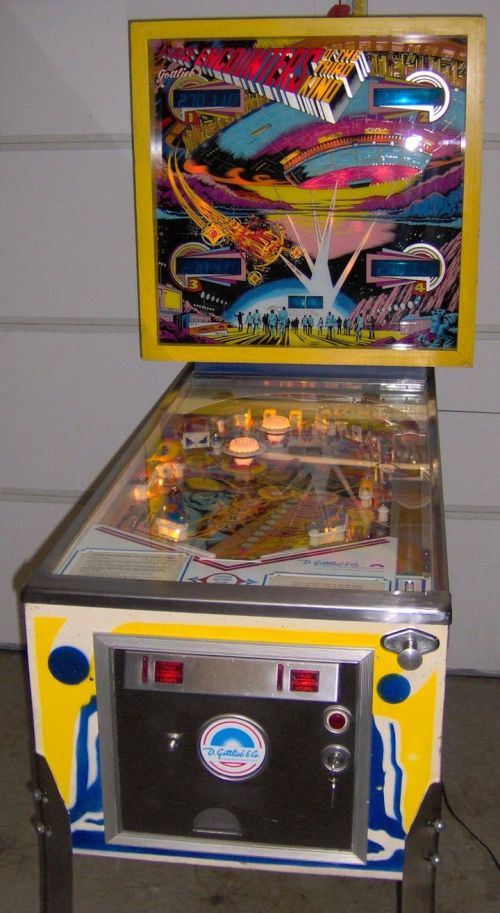(Image via Pinterest)
Archive for the 'Close Encounters of the Third Kind' Category
Close Encounters of the Third Kind Bendable Extra Terrestrial Figure (Imperial, 1977)
Published January 27, 2016 Close Encounters of the Third Kind , Imperial Toy Corporation 3 Comments(Image via Pinterest)
Close Encounters of the Third Kind Pinball Machine (Gottlieb, 1978)
Published November 19, 2015 Close Encounters of the Third Kind , Pinball 1 CommentDesigned by Ed Krynski with art by Gordon Morison, both of whom worked on the psychedelic 2001 and Dimension machines, as well as Astro and Orbit, all of them released by Gottlieb in 1971.
All images are via the Internet Pinball Database.
Close Encounters of the Third Kind Ringer T-Shirt, 1977
Published November 19, 2015 '70s Decor/Design/Fashion , Close Encounters of the Third Kind 4 Comments‘Prayer: Close Encounter of the Best Kind’ T-Shirt, Circa 1978
Published August 14, 2015 '70s Decor/Design/Fashion , Close Encounters of the Third Kind 2 CommentsToy companies weren’t the only ones trying to capitalize on the sci-fi fever of the late ’70s. Organized religion had taken a beating throughout the ’60s, with Star Trek, The Lord of the Rings, H.P. Lovecraft, and other eccentric narratives offering the rebellious young more compelling mythologies. UFOs were mysterious and poetic. Christianity was authoritarian and dogmatic. And then came Star Wars…
As I’ve said elsewhere, the “satanic panic” of the ’80s was more a backlash against the changing nature of youth than anything else. The real devil inside was imaginative, independent-minded kids who decided for themselves what they wanted to believe in.
(Images via eBay)
Board Games: Close Encounters of the Third Kind (Parker Brothers, 1978)
Published April 9, 2015 Board Games/Tabletop Games , Close Encounters of the Third Kind , UFOs 1 CommentThe game doesn’t look terribly different than Avalon Hill’s UFO: Game of Close Encounters from the same year. The first board game named after and featuring UFOs may be Flying Saucers, published in 1968 by Funland.
The Bermuda Triangle by Isao Tomita (RCA, 1978)
Published April 7, 2015 '70s Music , Close Encounters of the Third Kind , Electronic Music , Occult/Supernatural Leave a Comment
Tomita’s The Bermuda Triangle is essential electronica from one of the genre’s pioneers. Moog music hit the mainstream when Wendy Carlos’ Switched-On Bach (Columbia, 1968), a note-by-note rendition of various compositions by the beloved composer, landed on the Billboard top 10. Tomita, heavily influenced by Carlos, here mixes classical phrases and original music to contribute his own quirky version of the Triangle myth, at one point quoting the famous contact music from Close Encounters of the Third Kind.
Like Bigfoot and all manner of strange beasts, ancient aliens, and lost worlds, interest in the Bermuda Triangle had been building for more than a decade. The area’s supposed supernatural origins became entrenched in the popular imagination thanks mainly to three books: Invisible Horizons (1965) by Vincent Gaddis (who coined the phrase “Bermuda Triangle” in an earlier Argosy article), Limbo of the Lost (1969) by John Wallace Spencer, and The Bermuda Triangle (1974) by Charles Berlitz. (A “documentary” based on Berlitz’s “non-fiction” book was released in 1979.)
The cover art for the American release of Tomita’s The Bermuda Triangle is by Don Punchatz (1936-2009), who made a name for himself with cover art for new editions of Asimov’s Foundation trilogy published by Avon Books in 1966. He had a distinguished career in a golden age of commercial illustration—Ray Bradbury called his work “endlessly stunning”—and is probably best known for his cover and logo art on id’s Doom (1993), one of the more iconic pieces of video game art in creation.
Close Encounters of the Third Kind Poster Pen Set (Craft House, 1978)
Published November 21, 2014 Arts and Crafts , Close Encounters of the Third Kind , Posters/Poster Art/Poster Pen Sets/Paint by Number 2 CommentsPoster pen sets and poster art became popular during the latter half of the 1970s, part of a general arts and crafts surge that included everything from latch hook rugs to paintable figurines. (The oversized, “fine art” coloring books innovated by Troubador Press were an obvious inspiration.) There were poster sets before Star Wars, but Star Wars kicked the format into overdrive, making it relevant and exciting to the emerging geek generation.
(Images via eBay)



























